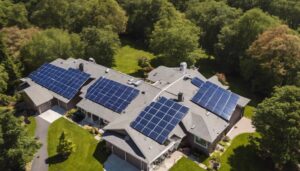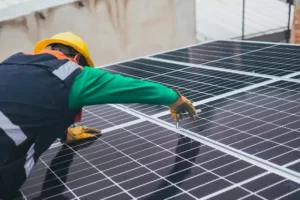You might not be aware that the time it takes to install solar panels can vary significantly based on factors you've perhaps not considered. While you might think it's a straightforward task, the truth is, elements such as the complexity of your roof, local permitting processes, and even the time of year can greatly influence the project's duration. As you look into making your home more sustainable, understanding these nuances will equip you with the knowledge to plan effectively. Let's explore what dictates the timeline of a solar panel installation, ensuring you're not left in the dark about what to expect.
Key Takeaways
- Solar panel installation time varies due to factors like site assessment, permitting, and weather conditions.
- Equipment availability and roof readiness directly impact the speed of installation.
- Post-installation steps, including inspection and utility connection, are vital for project completion and success.
- Homeowner readiness and proactive planning can significantly reduce delays and ensure timely project execution.
Understanding Project Duration
Understanding the project duration for installing solar panels requires a precise analysis of multiple factors, including site assessment, permitting, and the actual installation process. Weather impact and homeowner readiness are pivotal components that significantly affect this timeline. When considering the technical aspects, it's essential to recognize how unpredictable weather patterns can delay site assessments and the physical installation. For instance, heavy rainfall or extreme winds not only hinder work progress but may also necessitate additional safety measures, thus extending the project duration.
On the other hand, homeowner readiness plays a crucial role in streamlining the process. It encompasses the preparedness of the site for assessment, timely decision-making, and the swift submission of necessary documents for permitting. A homeowner's prompt responsiveness to these prerequisites can markedly reduce delays, ensuring the project adheres to the estimated timeline.
Therefore, a comprehensive understanding of these variables—weather impact and homeowner readiness—is indispensable. It enables a more accurate prediction of the project duration by factoring in elements beyond the control of the installation team, as well as those that rely on the homeowner's efficiency. This analytical approach ensures a realistic expectation of the solar panel installation timeline, minimizing potential frustrations.
Factors Influencing Installation Time
Several factors critically influence the time required to install solar panels, ranging from equipment availability to the complexity of the electrical setup at your property. When you're gearing up for solar panel installation, it's essential to consider these elements meticulously to set realistic expectations for the project timeline. Here's a closer look at these factors:
- Equipment Availability: The lead time for acquiring the necessary solar panels and inverters can significantly impact your project's schedule. Supply chain disruptions or high demand for specific models may extend the waiting period before the installation process even begins.
- Weather Conditions: Solar panel installations are outdoor projects, making them susceptible to weather-related delays. Inclement weather, such as heavy rain or extreme winds, can halt work to ensure the safety of the installation team and protect equipment from damage.
- Roof Readiness: The condition of your roof plays a pivotal role. A roof that requires reinforcement or repairs to handle the weight and structure of solar panels will add time to your project. Furthermore, the complexity of your roof's design can influence the installation's duration, with more intricate designs necessitating additional planning and labor.
Understanding these factors will help you appreciate the nuances involved in scheduling and executing a solar panel installation project.
Installation Process Overview
The installation process for solar panels involves a series of meticulously planned and executed steps, ensuring the system's optimal performance and longevity. It begins with site preparation, a critical stage where you ensure the installation area is clear and structurally ready. During this phase, potential shading obstacles are identified and mitigated, and the roof's integrity is thoroughly assessed to support the added weight of solar panels.
Equipment delivery is the next pivotal step. It's when all necessary components, including panels, inverters, and mounting hardware, arrive on-site. This stage requires precise coordination to ensure that the delivery aligns with the installation schedule, preventing any delays in the process.
To create imagery in your mind, consider the following table outlining key installation steps:
| Step | Description |
|---|---|
| Site Preparation | Clearing the area, assessing structural integrity, and addressing shading. |
| Equipment Delivery | Coordinated arrival of panels, inverters, and mounting hardware. |
| Mounting System Installation | Securing the framework that holds panels in place. |
| Panel Installation | Attaching panels to the mounting system, ensuring secure and optimal placement. |
Each of these steps is executed with precision, aiming for a seamless, efficient installation process.
Post-Installation Steps
Following the meticulous installation of your solar panels, it's crucial to focus on the necessary post-installation steps to ensure system optimization and compliance. These steps are designed to maximize the efficiency and longevity of your solar energy system. Here's a succinct guide to what you should do next:
- Inspection and Approval: Your solar system must be inspected by local building and electrical inspectors to ensure it meets all relevant codes and standards. This is a critical step for safety and compliance, and it typically involves a thorough review of the wiring, mounting, and overall installation quality.
- Utility Connection and Net Metering Setup: Once approved, you'll need to coordinate with your local utility company to connect your solar panels to the grid. This process may include setting up net metering, which allows you to send excess electricity back to the grid in exchange for credits on your utility bill.
- Maintenance Schedule and Warranty Registration: Establishing a regular maintenance schedule is essential for the ongoing health of your solar system. Additionally, don't forget to register your system with the manufacturer to activate the warranty. This step is crucial for ensuring you're covered in case of any defects or performance issues.
Assessing Project Success
You'll often need to rigorously evaluate the performance metrics of your solar panel system to ascertain its success post-installation. This assessment isn't just a cursory glance at whether the lights turn on; it delves deep into the intricacies of system efficiency, energy production, and return on investment. A critical component of this evaluation is customer satisfaction. It's essential to gauge how the system meets the user's expectations in terms of energy savings and usability. Feedback can highlight areas for improvement, not just in the hardware but in the overall service provided.
Moreover, maintenance efficiency plays a pivotal role in the long-term success of a solar panel installation. A system that's easy to maintain, with accessible components and clear guidelines, significantly enhances customer satisfaction. It also reduces the likelihood of downtime, ensuring a steady flow of clean energy. Analyzing maintenance records can provide insights into the system's reliability and the effectiveness of the support services.
In wrapping up the assessment, it's crucial to compare the initial projections with the actual performance data. This comparison will offer a clear picture of the project's success, guiding future installations and improvements. By focusing on these technical and customer-centric metrics, you can comprehensively evaluate the success of your solar panel installation project.
Conclusion
In conclusion, the duration of solar panel installation is contingent upon multiple variables including project scale, site-specific conditions, and regulatory compliance. The process, from initial assessment to operational status, involves meticulous planning and execution. Post-installation, evaluating system performance is crucial for validating the project's success. It's essential to approach the timeline with flexibility, understanding that precision in each step ensures long-term efficiency and sustainability of your solar investment.



